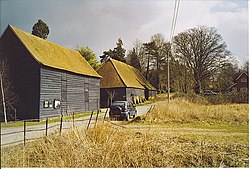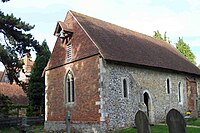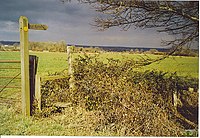Wanborough, Surrey: Difference between revisions
No edit summary |
|||
| Line 15: | Line 15: | ||
|constituency=Guildford | |constituency=Guildford | ||
}} | }} | ||
'''Wanborough''' is a small hamlet in [[Surrey]] approximately | '''Wanborough''' is a small hamlet in [[Surrey]] approximately five miles west of [[Guildford]] on the northern slopes of the [[Hog's Back]]. Neighbouring villages include: [[Puttenham]] and [[Christmas Pie]]. Wanborough has grown up around and to service ''Wanborough Manor''. | ||
Wanborough has gradually become a commuter village for Guildford and London, served as it is by Wanborough station on the Ascot to Guildford line and the North Downs Line, albeit that Wanborough station is in fact in nearby [[Flexford]]. | Wanborough has gradually become a commuter village for Guildford and London, served as it is by Wanborough station on the Ascot to Guildford line and the North Downs Line, albeit that Wanborough station is in fact in nearby [[Flexford]]. | ||
Revision as of 11:50, 5 August 2015
| Wanborough | |
| Surrey | |
|---|---|
 The Great Barn, Wanborough | |
| Location | |
| Grid reference: | SU934489 |
| Location: | 51°13’54"N, -0°39’45"W |
| Data | |
| Population: | 319 (2001) |
| Post town: | Guildford |
| Postcode: | GU3 |
| Dialling code: | 01483 |
| Local Government | |
| Council: | Guildford |
| Parliamentary constituency: |
Guildford |
Wanborough is a small hamlet in Surrey approximately five miles west of Guildford on the northern slopes of the Hog's Back. Neighbouring villages include: Puttenham and Christmas Pie. Wanborough has grown up around and to service Wanborough Manor.
Wanborough has gradually become a commuter village for Guildford and London, served as it is by Wanborough station on the Ascot to Guildford line and the North Downs Line, albeit that Wanborough station is in fact in nearby Flexford.
The A31 road runs along the top of the Hog's Back nearby.
Parish church

St Bartholomew's, the village church, is small; only 44 feet by 18 feet internally. It was originally built around 1060 replacing an earlier wooden Anglo-Saxon church. It was rebuilt in the 13th century and restored in 1861. Thus the various walls and windows have significantly different heritage. The Victorian west brick wall now supports an external bell.
History
Early history
According to a local publication Wanborough and its Church,[1] early man travelled along the Hog's Back, found the spring in the village and had settled there by 8000 BC. The Saxon name of Wenberge means bump-barrow, this barrow was south of Wanborough on the top of the Hog's Back.
Wanborough appears in Domesday Book of 1086 as Weneberge. It was held by Goisfrid (Geoffrey) de Mandville. Its domesday assets were: 3 hides; 1 church, 9 ploughs, 6 acres of meadow, woodland worth 30 hogs. It rendered £7.[2] It also states that it had been held before the Norman conquest by two thegns, Sweign and Leofwin, who might have been the brothers of King Harold II.
In 1130 the Manor was sold to Waverley Abbey for £80 and put to use to farm sheep to supply the Cistercians. The present Great Barn was built in 1388 and was used for storing and processing crops (threshing and winnowing). Having been built for the Cistercian Abbey, the barn was not a tithe barn, and would have stored the entire manor crop. The barn is made from massive oak timbers and is an aisled barn with large doors on either long side to permit entry by carts. It was extended in 1705. The dates have been obtained using tree-ring dating techniques.
In 1511, Waverley Abbey obtained the right to hold an annual fair at Wanborough for 3 days from 23 August and by 1536 the fair was making £35 for the abbey and had a pie poudre court to try trading offences.
Modern period
In 1536, Waverley Abbey was dissolved and the manor passed into secular ownership. St Bartholomew's Church was in regular use until at least 1675, but by the 18th century the Quaker Birkbeck family were farming the hamlet innovating with 'modern techniques' and they used the church as a wood store and barn.
The present manor house was built starting in about 1670 by Thomas Dalmahoy, who was one of the members of Parliament for Guildford for most of the reign of King Charles II.
Whilst nearby Puttenham church was closed for repairs it was decided by their Rector, the Rev W A Duckworth, to hold services in Wanborough's church. He thus arranged and paid for the restoration of St Bartholomew's by architect Henry Woodyer. It was rededicated in 1861.
From 1880, Sir Algernon West lived at the manor. Principal Private Secretary to Prime Minister William Ewart Gladstone, Sir Algernon entertained many great figures of the age at the manor including Gladstone, Queen Victoria, and Bismarck. Sir Algernon was also a director of the South Eastern Railway and he caused a new station, named Wanborough but actually in Normandy, to be opened in 1891. In 1900, the manor was passed to Herbert Asquith until he became Prime Minister. In 1908, Sir Algernon West returned to stay until his death in 1921.
Second World War
During Second World War the manor was converted into a training centre for Special Operations Executive agents. The manor was designated Special Training School 5 and handled the first three phases of agent training. It operated from spring 1941 to March 1943 under the command of Major Roger de Wesselow, a Coldstream guards officer in First World War. Many agents in 'Section F' (France) passed through STS5 and courses lasted 3 weeks. Each course was specific to one country and, during the course, all conversation was in the target language. Trainees were taught theoretical and practical subjects including physical training, shooting, explosives, sabotage, map-reading, Morse code, and observation skills.
Outside links

| ("Wikimedia Commons" has material about Surrey Wanborough, Surrey) |
- Great Barn
- Detailed historical record about the Great Barn, Wanborough
- Wanborough Barn
- Stained Glass Windows at St Bartholomew, Wanborough, Surrey
References
- ↑ Anon Wanborough and its Church (available from the church)
- ↑ Surrey Domesday Book
